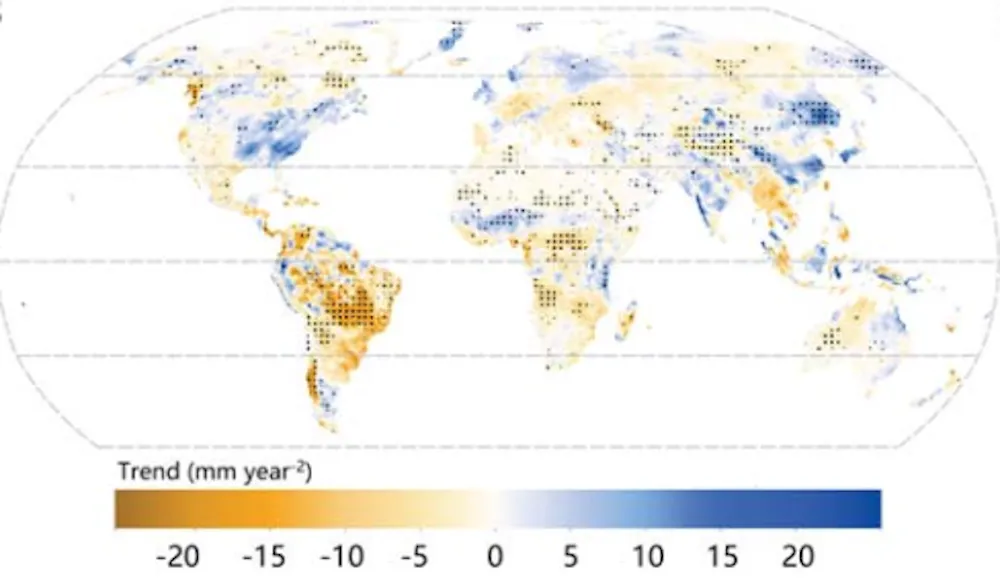In a revelation that underscores the urgency of climate issues, scientists are reporting a concerning trend: the Southern Hemisphere is gradually becoming drier, with potential repercussions for ecosystems, agriculture, and human life.
The Scarcity of Freshwater
Water is fundamental to life on Earth, yet the fresh water we rely on—drinkable and accessible to land-dwellers—makes up a mere 1% of all the water on our planet. Most of the Earth’s water is either salty ocean water or trapped in ice and underground. As the climate changes, how this precious 1 percent is distributed across the globe becomes crucially important.
The Draining South
Researchers have uncovered a pattern over the past 20 years (2001-2020) that sees the Southern Hemisphere losing moisture faster than its northern counterpart. This conclusion comes from analyzing satellite data and river flow measurements. The main culprit, the study suggests, is El Niño, a climate pattern where the eastern Pacific Ocean warms up and disrupts normal weather activities.
Water availability, which is the balance between rainfall and the water that evaporates or is used by plants, is changing, and it’s not for the better in the south. While the Southern Hemisphere has less land, the impact of its drying is significant on global water availability.
Where the Water Wanes
The research points to a stark decrease in water in regions like South America, much of Africa, and parts of Australia. Interestingly, some areas, like southern South America, might see an increase in water resources.
In contrast, the Northern Hemisphere maintains a relatively balanced water availability, helped by human interventions like irrigation and dams, where a vast majority of the global population resides.
The Ripple Effects of Drying
So why is this drying trend worrisome? The implications are vast. The Amazon rainforest, which is vital for climate regulation and rich in biodiversity, faces increased fire risk and could release massive amounts of carbon if it dries out. South America’s role as a significant agricultural exporter means changes in water availability could stress global food systems.
Africa’s vast and varied climate zones are drying out, which is particularly concerning given the continent’s limited resources to combat such changes. This drying can lead to reduced agricultural yields, impacting exports and escalating poverty and hunger.
In Australia, both the northwest’s wilderness and the central region face temperature rises and changes in vegetation, impacting weather patterns and leading to wildfires, river depletion, and health issues, especially in urbanized coastal areas.

Complex Climate Patterns and Uncertain Futures
The paper underscores that these shifts in the Southern Hemisphere during El Niño events hint at a more arid future, with intricate climate processes at play. The certainty of these patterns is challenging to pinpoint on local or regional levels, but the overarching trend is clear: less water will be available, straining habitats, species, human populations, and our global food supply.
The Domino Effect of a Drier Southern Hemisphere: What To Expect
The gradual desiccation of the Southern Hemisphere’s landscapes is more than a regional concern—it sets off a chain of ecological and socio-economic dominoes that can have far-reaching consequences. Below are key examples that illustrate the potential for long-term damage and the breadth of impact this environmental shift can have:
More To Discover
- China’s Massive Trawler and Fishing Fleet Is Causing Devastation In And Out of The Ocean and No One Will Stop Them
- How Media’s Single-Use Mask Bias Contributed to PPE Pollution During The Pandemic
- Australia’s Coffee-Concrete: 30% Stronger Pavement With Recycled Coffee Grounds
- Canada Trails in the Fight Against Greenwashing
- Ecosystem Disruption:
- Decline of the Amazon rainforest, leading to loss of biodiversity and disruption of global climate regulation.
- Increased wildfires, resulting in habitat destruction and air quality deterioration.
- Shifts in vegetation patterns, causing further temperature increases and ecological imbalance.
- Agricultural Impact:
- Decreased yields of staple crops like cassava, leading to food insecurity.
- Reduced production of export crops such as coffee and cocoa, affecting global markets and local economies.
- Increased stress on water resources for irrigation, challenging existing agricultural practices.
- Socioeconomic Challenges:
- Escalating poverty and hunger due to reduced agricultural productivity and loss of livelihoods.
- Migration and displacement as communities seek more habitable environments.
- Heightened competition for diminishing water resources, potentially leading to conflicts.
- Health and Human Well-being:
- Increased health risks from heatwaves and poor air quality due to fires and dust storms.
- Spread of waterborne diseases as water scarcity impacts sanitation and clean water access.
- Psychological stress and anxiety related to environmental instability and economic pressures.
- Biodiversity Loss:
- Extinction of species unable to adapt to rapidly changing conditions or migrate to suitable habitats.
- Disruption of pollination networks, affecting plant reproduction and food supply.
- Loss of genetic diversity, undermining ecosystems’ resilience to future climate changes.
- Climatic Feedback Loops:
- Release of carbon from drying forests, exacerbating global warming.
- Altered weather patterns, affecting rainfall and storm activities far beyond the Southern Hemisphere.
- Accelerated melting of glaciers due to changing atmospheric dynamics, leading to sea-level rise.
- Ecosystem Disruption:
As the Southern Hemisphere contains vast oceans, what happens there is pivotal for the entire planet. The slow drying out of this part of the world is a global concern, signaling a need for heightened awareness and action on climate change.
Source: Science



















